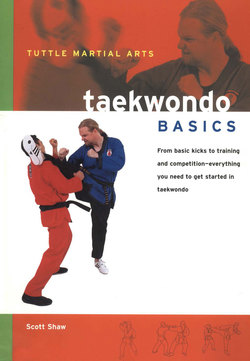Читать книгу Taekwondo Basics - Scott Shaw - Страница 10
На сайте Литреса книга снята с продажи.
ОглавлениеWTF and ITF
THERE ARE TWO primary branches for the art of taekwondo. They are: The World Taekwondo Federation (WTF), headquartered at Kukkiwon in Seoul, South Korea, and the International Taekwondo Federation (ITF), originally based in Canada. Of these two, the WTF possesses substantially more members.
The Differences and Similarities
The differences between these two primary branches of taekwondo principally involve their emphasis on self-defense. Whereas ITF taekwondo has kept its primary focus upon self-defense, with competition as its secondary concentration, WTF taekwondo has come to place its primary emphasis upon competition. WTF taekwondo has caused many of the traditional taekwondo techniques to be streamlined, refined, and focused upon a minimum of movement. This is not to imply that the WTF student does not learn self-defense, however, because what a student actually learns in the various schools affiliated with one of these governing bodies is largely determined by the instructor.
These two institutions prescribe different sets of forms for their students to practice. However, although these differ in defensive and offensive implementation, they both utilize the same style of techniques. The language of the two groups is also somewhat different. The various fighting techniques are oftentimes referred to by different Korean terminology. The essence of these techniques remains the same, however.
Ultimately, there are more similarities than differences between these two primary branches of taekwondo. The techniques they teach are based upon the same fundamental understanding of self-defense, and the martial philosophy is very much the same.
Although the WTF and ITF are the two largest branches of taekwondo, there are an untold number of smaller organizations that exist to promote the art of taekwondo throughout the world. Of these, perhaps the most noteworthy are the original kwans.
The Kwans
It was the hope of the Korea Taekwondo Association that all of the original Korean kwans would merge, drop their names, and move taekwondo forward under the guidance of one overseer organization. To some degree, this did occur. Most notably, the name "taekwondo" was accepted by all of the original kwans, and most kwans practice the same set of WTF preset training forms—now most commonly known by the Korean word poomse. What also occurred, however, was that virtually all of the original kwans held onto their names and continued to promote their own unique interpretation of taekwondo. They never wholly dissolved. In some cases, the original founder of the kwan is still alive. In other cases, the kwan is run by an elected president. Thus, the kwans are still very much in existence and continue to issue rank and instructor certification.
Virtually all of the remaining original Korean kwans are associated with the WTF. In some instances, a black-belt kwan member is certified by both the kwan and the WTF. More commonly, however, especially in the West, this is not the case. Rank certification comes solely from the kwan. As the WTF no longer recognizes kwan certification, certified kwan members must then go through additional testing at Kukkiwon if they wish to hold WTF rank or instructor certification.
The propagation of the kwans has also continued. Many taekwondo masters, originally certified by a kwan, have created organizations all around the world that bear the name of the original kwan but are no longer directly linked to it. These organizations commonly provide rank and instructor certification sanctioned solely by the individual association.
Affiliate Organizations
Under the umbrellas of the WTF and the ITF are smaller, affiliated organizations. These associations are based throughout the world and were founded by advanced masters of taekwondo in order to promote the ongoing expansion of their parent organization. In most cases, these affiliate associations offer rank and instructor certification from both their own association and their parent organization. These groups are designed to provide a student or instructor with a direct link to one of the primary governing bodies.
Olympic Taekwondo
The WTF is the sole source for taekwondo's inclusion in the Olympic Games. Therefore, the WTF has designated governing bodies that function to promote taekwondo as an Olympic sport. There are two levels of these groups. The first are the larger administrative bodies that oversee entire continents. They are the Africa Taekwondo Union (AFTU), the Asia Taekwondo Union (ATU), the European Taekwondo Union (ETU), and the Pan American Taekwondo Union (PATU). Under the direction of these associations are the national governing bodies that oversee Olympic-style taekwondo competitions and organize national teams.
To participate in any sanctioned Olympic-style event, a taekwondo practitioner must become a member of the organization in his or her country that has been established for this purpose.
Independent Organizations
Many countries around the world have seen the rise of independent taekwondo organizations. These independent groups are commonly founded with the premise that their organizers do not wish their curriculum to be governed by an overseer association. As a result, the majority of these associations are not formally affiliated with either of the two primary governing bodies and are not formally associated with any of the original Korean kwans. Thus, all of their rank and instructor certifications are wholly organization-based.
In some cases, these independent associations have been founded by advanced masters of taekwondo who are certified by one of the two primary associations and perhaps one of the original kwans. In other cases, independent organizations have been founded by individuals trained in a more eclectic style of taekwondo that possesses little resemblance to the traditional art. Over the years, some independent organizations have become established and respected entities, while others lasted for a while and then dissolved.
